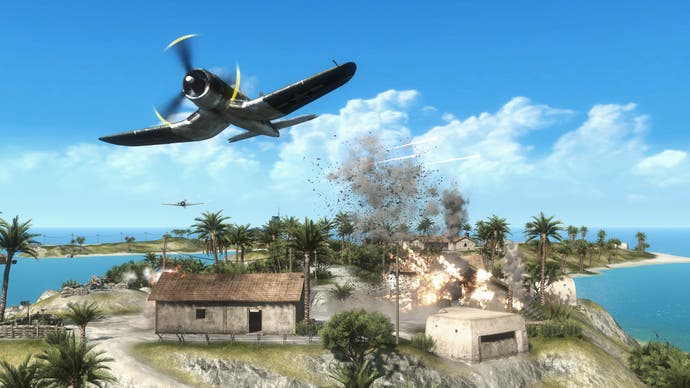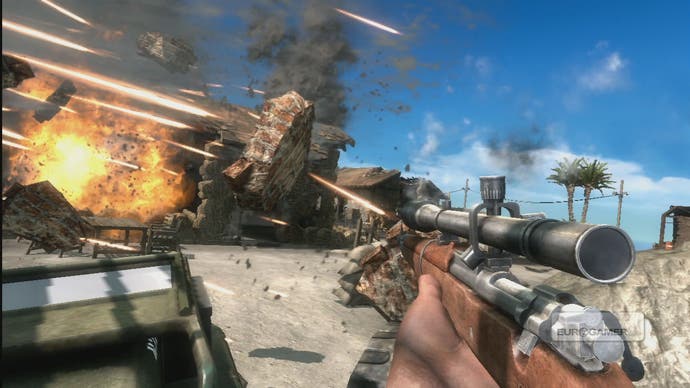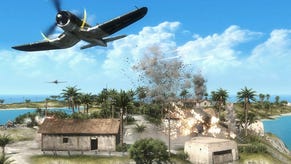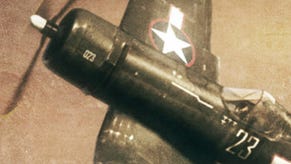Battlefield 1943
War is heck.
It's a testament to DICE's original multiplayer war game that even though there's been a spin-off or expansion every year since 2002, many people have been holding out for a proper World War 2 sequel for seven years. That this sequel arrives on consoles first, rather than PC, and as a bargain-priced digital download no less, reveals much about how gaming has changed since we first planted our boots in Battlefield's bloody, muddy soil.
This is undeniably Battlefield stripped down and pared back for a new generation of gamers. Those familiar with the PC original would be forgiven for being taken aback at just how slender the available options are, in almost every area. This ruthless focus is actually one of the game's strengths, at least in the short term, but it remains to be seen how such a skeletal starting point will sustain itself over the coming months.
It's war as Groundhog Day, a neverending series of skirmishes set in the Pacific theatre, but for many players it's getting started that has been the problem. Plagued by server problems and lag in its first 48 hours of public play, such technical sluggishness casts a pall over those all-important first impressions. Spending upwards of 30 minutes hitting the Quick Match button over and over really isn't something we should have to do for an online-only title with this sort of pedigree. Assuming these issues are resolved quickly, however, there's no reason to hold the teething troubles against the game itself. Once you do manage to get past the obstinate "No games found" message, you'll find a marvellously intuitive multiplayer shooter with a commendably balanced design.

It's the US versus Japan, and each nation boasts just three classes of soldier: Rifleman, Infantry and Scout. These come with a standard load-out of weaponry. A primary weapon, from the Infantry's close-quarters machine gun to the Scout's long-distance sniper rifle; a secondary weapon, usually something explosive; and grenades or remote charges. There's also a variety of mounted machineguns and AA cannons to choose from, and an air raid accessible from radar stations that allows you to steer a trio of bombers over the map, pounding a target with clusters of bombs.
That's your lot, so anyone hoping to tweak and customise their kit in detail will be sorely disappointed. The same holds true of vehicles. Both sides have tanks, jeeps, gunboats and fighter planes. They look slightly different, but all have the same weaponry in the same positions. Neither side has the advantage in any area simply because of their default arsenal, but anyone finding themselves pummelled in one area can always earn some points by trying something else. Manning an anti-air battery and shooting down enemy fighters is always good for a few ranks, as is taking a cunning approach and sneaking around to claim undefended bases for an instant 30-point bonus.

There's only one game mode though, a simple and mostly idiot-proof base-capture which keeps teams moving between five strategic points on the maps. Wresting control of these locations from the opposition is key to victory. The match doesn't simply end when you capture all of them, but instead your enemy's respawn tickets are depleted faster the more bases you hold. There's no health bar and ammo is infinite, with a small recharge time the only penalty for running dry, so the omnipresent respawn gauge is the only HUD detail you need to worry about.
There are also just three island maps on which to wreak havoc. Guadalcanal and Iwo Jima are fairly similar, offering a range of elevated hills, winding paths and trenches to scurry around. Wake Island is notable for its horseshoe shape, which has a distinct impact on the gameplay. There's also a fourth map-cum-mode, the mysterious dogfight-heavy Coral Sea, which will only be unlocked after a community event in which players have to rack up a cumulative 43 million kills (that's 43m each for PS3 and Xbox 360). All, however, are cleverly designed to keep the action moving around the map - the current conflict hotspot is always shown on-screen with a crossed-swords icon - without ever feeling like you're being herded for the sake of a cheap chokepoint. You instinctively learn the tricks and tactics that work best for each location, an evolving mental checklist that treats the terrain as a tangible place with consistent rules - always a good indication that the design is working.











